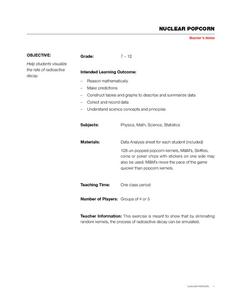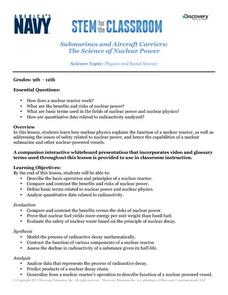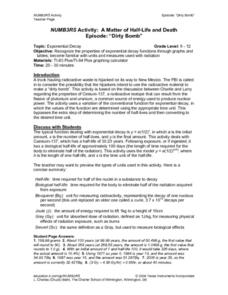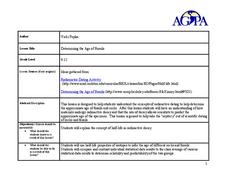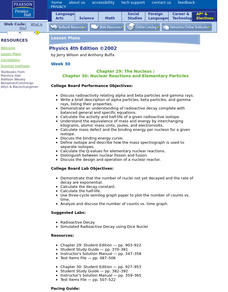Kenan Fellows
Half-Life
Scholars shake their way to understanding half-life with the help of candy. They observe and record which side candy lands on to graph the exponential decay in the fifth lesson of seven integrating chemistry and algebra. Combining...
Curated OER
Half-life Worksheet
In this half-life worksheet, students determine how long it takes for a 100g sample of AU-198 to decay to 6.25g. Then they determine the half-life of a radioactive isotope if a 500.0g sample decays to 62.5g in 24.3 hours. Students also...
National Museum of Nuclear Science & History
Nuclear Popcorn
Make your instructional activity on radioactive decay pop with this lab exercise. Using popcorn kernels spread over a tabletop, participants pick up all of those that point toward the back of the room, that is, those that represent...
Curated OER
Working with Half-Life
In this half-life worksheet, students use a given table of half lives, mass, time and amount of original sample to solve for unknowns in nine given half-life problems.
Discovery Education
Submarines and Aircraft Carriers: The Science of Nuclear Power
As physics masters view this presentation, they learn how nuclear power is used in submarines. They use Google Maps to plot a course through the ocean and calculate the time required for surfacing and traveling. They learn about fission,...
Curated OER
NUMB3RS Activity: A Matter of Half-Life and Death
Students investigate exponential decay. Students explore the biological half-life of Cesium-137. Students investigate the Goiania Accident of 1987 which is considered one of the worst incidents in the history of the Atomic...
Curated OER
Half Lives
Students investigate the concept of half-life by conducting an M&M experiment. In this chemistry instructional activity, students differentiate nuclear fusion and fission. They present investigation findings to class.
Curated OER
Radioactive Decay and Half-Life
Learners describe how the mass of a radioactive isotope changes with time and the factors that affect the rate of radioactive decay. They write nuclear decay equations to represent natural transmutation. This activity is accomplished...
CK-12 Foundation
Marie Curie's Classroom
What makes some elements stable and others radioactive? Scholars adjust the number of protons and neutrons in an element then observe its decay. The simulation includes a graphical representation and the chemical formula, as well as...
CK-12 Foundation
Radiocarbon Dating
How do we know how long ago a dinosaur lived or an ancient fire pit was used? Scholars learn about the application of carbon dating and half lives to discover things about the past. They adjust the amount of radioactive carbon in the...
Curated OER
Chem 152-Nuclear Chemistry
In this nuclear chemistry worksheet, students answer ten questions about radioactive decay, half life, electron capture and alpha emission.
Curated OER
Radioactive Decay: A Sweet Simulation of a Half-life
Students demonstrate rates of decay of unstable nuclei can be measured. They understand ratios and multiplication of fractions. They simulate radioactive decay. They read about the accomplishments of scientists.
Curated OER
Nuclear Chemistry Worksheet
In this nuclear chemistry worksheet, students solve nine problems about half life, positron emission, nuclear fission and nuclear fusion.
Curated OER
Radioactivity-What is the Nucleus Like?
For this radioactivity worksheet, high schoolers answer 40 questions about half life, isotopes, radioactive decay, the uses of radioactivity, nuclear equations and the scientists associated with radioactivity.
Virginia Department of Education
Determining Absolute Age
How can radioactive decay help date old objects? Learners explore half-life and radioactive decay by conducting an experiment using pennies to represent atoms. Young scientists graph data from the experiment to identify radioactive decay...
Curated OER
Nuclear Chemistry Homework Problem Set
In this nuclear chemistry worksheet, students evaluate data from concentration experiments on radioactive iodine. They graph the data, determine radioactive decay and half life for the element.
Curated OER
Radioactivity
In this radioactivity worksheet, students write the mass number and atomic number for the missing element in the reactions. Students identify the isotope that is more stable and determine the half-life of the isotope. This worksheet has...
Curated OER
Radioactive Simulations
High schoolers simulate radioactive decay and nuclear power using an on line interactive web site. In this on line lesson plan, students monitor radioactive isotopes and record the activity of a particular element as the decay...
Curated OER
Radiation
Students distinguish between natural and man-made radiation. They measure radiation using a Geiger counter and investigate footprints of radiation.
Curated OER
Nuclear Chemistry
In this nuclear chemistry activity, students answer 9 questions. They balance nuclear equations, they write balanced equations, they calculate decay and they find binding energy of atoms.
National Museum of Nuclear Science & History
Alphas, Betas and Gammas Oh, My!
Referring to the periodic table of elements, nuclear physics learners determine the resulting elements of alpha and beta decay. Answers are given in atomic notation, showing the atomic symbol, mass, atomic number, and emission particles....
Curated OER
Determining the Age of Fossils
Students examine the concept of radioactive dating. In this radioactive dating lesson, students investigate how to determine the ages of fossils and rocks as they learn about half-life radioactive decay.
Curated OER
The Nucleus / Nuclear Reactions and Elementary Particles
Students describe how radioactivity relates to alpha and beta particles. Using their properties, they write a descriptive paper about the gamma rays and alpha and beta particles. They calculate q-values and the half-life of a given...
Curated OER
Not In My Backyard: The Nature and Danger of Nuclear Radiation
Young scholars evaluate the ways to control exposure to radiation and determine how to deal with the problem of nuclear waste in a rational rather than an emotional way.




